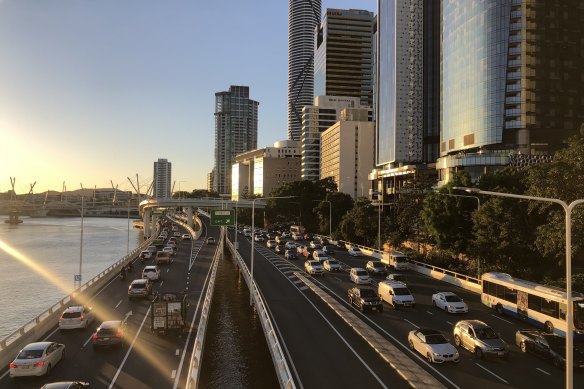- Perspective
- National
- Queensland
- Traffic
London makes CBD drivers pay up. Should Brisbane introduce a congestion tax?
Traffic congestion in Brisbane is the worst.
Anyone who regularly crawls across the Captain Cook or Story Bridge, battles the Riverside Expressway and ICB during peak hour or frequents roads such as Coronation Drive and Brunswick Street knows this.
This year, a report found Brisbane was the most traffic-congested city in Australia (and 12th in the world), with drivers losing an average of 74 hours to traffic delays each year, compared with 62 hours in Melbourne and 53 hours in Sydney.

Despite billions of dollars spend on road infrastructure, Brisbane is the most traffic-congested city in Australia. Credit: Felicity Caldwell
This is despite the billions spent on underground tunnels and road upgrades, decisions that have worsened congestion in some instances. Turns out if you keep prioritising driving, more people continue to do it.
In August, the Labor government took a bold swing at traffic with the launch of 50¢ fares on public transport. The results have been a little lukewarm.
Data published this week revealed a minor drop in traffic on Brisbane’s main roads during the first month of the 50¢ initiative – a 1.3 per cent drop for motorway traffic and 0.8 per cent for arterial road traffic – followed by a partial rebound four weeks later.
So what will it take to transform traffic in this city?
Some think it’s time to consider a congestion tax.
Congestion tax or congestion pricing places a surcharge on drivers commuting through traffic-prone areas, such as central business districts, with the aim to disincentivise driving.
It’s been introduced in London, Singapore, Stockholm and, recently, Manhattan in New York City.
In 2019, the Grattan Institute released a discussion paper supporting a charge on motorists driving cars into Australia’s capital city CBDs, concluding that a congestion price was realistic in Sydney and Melbourne within a decade. Brisbane was not included in the study.
The last time a congestion tax was floated for Brisbane, in 2011, I still had a “1” at the start of my age.
“There’s been no move towards it since and in fact, Australia-wide, we’re more delayed on the whole road-pricing agenda than I thought we would be,” says Professor Matthew Burke, the deputy director of Griffith University’s Cities Research Institute.
Burke supports a congestion tax in Brisbane, particularly as more electric vehicles enter the market.
“Australia is still relying on fuel tax, and I am one of probably half a million [EV owners] who does not pay fuel tax, [and therefore] doesn’t contribute to paying for the national highway system.”
How a congestion tax would look in practice varies.
London, the most recognised example of congestion pricing, charges drivers entering its downtown core a flat rate of £11.50 (about $A20) on weekdays between 7am and 6pm.
Paris is about to take it a step further, implementing a Zone à Trafic Limité – “Limited Traffic Zone” – to ban private cars from driving into four of the city’s most central arrondissements if their final destination is outside the zone. People with disabilities, buses, taxis, emergency services, healthcare workers and delivery vehicles will be exempt.
“This proposal has just been announced for Paris as a legacy of the Olympics to dramatically cut the number of cars in the city centre,” Burke says. “Over half of those cars have no destination in the city centre – they’re going from one side of the city to the other.
“In Queensland, we’ve done the reverse.
“We created bypass roads. And despite the public policy purpose of that road being to put the traffic underground and encourage as many people as possible to bypass the city, we put a massive toll on the underground roads.”
Brisbane also has the most expensive off-street parking of any CBD in Australia.
Rob Lucas, of urbanism collective Greater Brisbane, also supports measures to disincentive inner-city driving. One of the group’s key campaigns is focused on building a “car-free CBD” by the Brisbane 2032 Olympic Games.
“The idea is that we can reclaim the space in our city that’s taken up by roads and private drivers to be used for more pedestrian and community engagement,” Lucas says.
“Obviously, that requires thought about how goods and services are delivered throughout the city and how we balance the availability of public transport, because we certainly want people to come into town.”
Critics note the effect congestion pricing could have on low-income earners, people with limited access to public transport and those with accessibility challenges – all of whom would need considered if a tax were to be introduced.
On the other hand, the revenue could be redistributed to improve public and active transport infrastructure and develop more pedestrian streets.
“It might be politically and practically difficult,” Lucas says,“but the benefit is not having private vehicles taking up so much of town and getting more utilisation out of our public transport.”